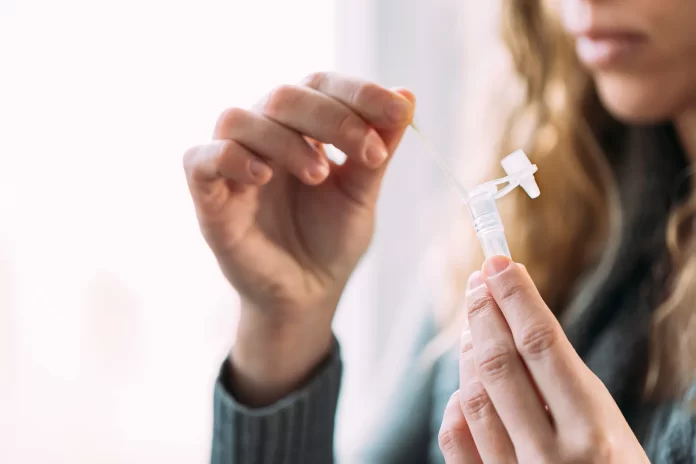March 11, 2024 – At-home medical diagnostic testing has exploded in recent years. NASDAQ reports that the market for at-home testing has reached a staggering $45.6 billion and will continue to grow at a rate of over 10% per year up to 2031.
COVID-19 testing may have gotten the ball rolling, but new home tests for a variety of conditions are becoming widely available. Do-it-yourself genetic tests for everything from thyroid disease, to sexually transmitted diseases (STDs), to heart disease, and more are cutting-edge options, as are inflammation-detecting tests that may spot early signs of conditions like Alzheimer’s.
Convenience is a major advantage when it comes to at-home testing, also sometimes called direct-to-consumer testing Those who think they may have sleep apnea, for example, but don’t want to endure the discomfort of a night in the hospital for a sleep study, have the option of an at-home evaluation – plus they can get fitted for a CPAP machine if needed.
While accessible, the evaluation is not foolproof, warned Brooke G. Judd, MD, an assistant professor of medicine and assistant professor of psychiatry at Dartmouth College’s Geisel School of Medicine.
“Although these devices report a number of metrics, including sleep time, sleep stages, and blood oxygen levels, it is important to understand that the algorithms for these metrics change quickly, and are still only providing estimates rather than accurate values,” said Judd, who is also the medical director of sleep medicine at Dartmouth Hitchcock Medical Center in Lebanon, NH.
There are other drawbacks to direct-to-consumer tests. New research from the University of Pennsylvania found that companies that make at-home tests don’t guarantee the same privacy rules a doctor’s visit automatically provides, and these tests often require the consumer to take on the responsibility of accuracy.
Read on for more must-knows about at-home medical testing, so you can decide if it’s right for you.
Are At-Home Tests Safe?
Yes – so long as the test has been approved by the FDA.
“When it comes to a true direct-to-consumer test, the FDA has always really emphasized safety,” said Mark Fendrick, MD, a professor of internal medicine, professor of health management and policy, and director of the Center for Value-Based Insurance Design at the University of Michigan in Ann Arbor. “These tests are incredibly well-studied.”
How Do You Take an At-Home Medical Test?
An at-home test works much like those you’re used to getting at your doctor’s office.
Typically, the process is:
- A consumer buys a test at a store or online.
- A DNA sample is collected – either saliva, urine, or blood – using the test kit instructions.
- The sample is mailed off to the company that makes the test. The sample is analyzed for certain genetic evidence that indicates a specific medical condition.
- Results then are sent to the consumer, usually through a secure web portal. Sometimes, the results are simply positive or negative; sometimes, a medical professional is available to interpret and discuss the results.
Specific Tests and How They Work
Sleep Apnea
Harvard Medical School estimates that 60% to 70% of these studies are now done using home evaluations. The sleep apnea test approved by the FDA, WatchPAT, is a disposable test that works by attaching finger and/or chest probes, rather than using a more complex head sensor system in traditional on-site sleep studies. You speak with a doctor through a telemedicine chat who approves you for the device. Then you use the device at home and send your sleep data to the company. Your data gets doctor-reviewed, and you’re sent a report with recommendations, including, potentially, for the CPAP machine. Research has shown that the WatchPAT has a positive predictive sleep apnea rate of 79% to 96%. Its accuracy for predicting a negative diagnosis of the condition is reported at 96%. It costs about $190 and is typically covered by insurance.
Inflammation
Inflammation home tests are sold under many brand names and range in price from about $25 to $100. Most of the time, the test involves a finger prick , and the blood sample is then mailed to these tests’ makers.
EmpowerDX offers one popular option. It sells a home test that measures C-reactive protein in the blood, which can indicate a range of health conditions. The company stresses the usefulness specifically of this test to find out if inflammation has activated your immune system. Some of these kits, such as a popular model from Everlywell, also measure vitamin D levels, to find out if they’re sufficient to activate your immune system.
The most significant test of this kind is made by Quest Diagnostics and was introduced to the market last summer as an early diagnostic tool for Alzheimer’s. It’s a blood test that measures beta-amyloid protein, which is a major indicator of the condition.
Sexually Transmitted Diseases, Including HIV
STD testing kits are available for about $100 through brands like CVS and commonly involve sending in urine samples. It usually takes about 5 to 16 days to get results back.
Hyperthyroidism and Hypothyroidism
Thyroid at-home blood test kits are offered by many companies, including Paloma Health. To ensure best accuracy, consumers should choose a kit that’s CLIA- and CAP-certified. You send in your sample and get digital results within a few days.
Waiting for Results
Waiting for the results of your at-home test can be nerve-wracking.
“I call it ‘screening purgatory,'” said Fendrick. “Is it really worthwhile for people to perhaps receive life-changing test results if they don’t have family, friends, or a support system to turn to?”
In deciding if you can handle the wait, he offered a suggestion.
“Before you start the test, think about what you might do if the result is positive OR negative.” If the condition you’re testing for is potentially serious, it might be better to receive in-person testing by a health care provider. This will get you results quickly, and you can access fast, professional medical advice.
Ensuring Accurate Results
In short: There isn’t 100% certainty, even with tests that have good accuracy rates.
“All medical tests have the potential to be inaccurate,” said Mary T. Gover, MD, an assistant professor of medicine at Albert Einstein College of Medicine and an internist with Montefiore Einstein Advanced Care in Bronx, NY. “There can either be a false positive or a false negative.”
A study from the University of Minnesota points out that direct-to-consumer testing can be unclear in terms of follow-up, too. The good news is, most people who take these tests do understand the importance of reporting this information to their doctors. The University of Michigan’s National Poll on Healthy Aging found that almost 50% of the people in the survey, ages 40 to 80, had used an at-home test. And 90% of those who’d bought a test for cancer brought their results to their health care provider, as did 55% of those who tested themselves for an infection.
If you get a positive test result, call your doctor right away to get retested, so the results can be confirmed. If your home test is proven accurate, your doctor can start any treatment that you need. And sometimes, you’ll find that you actually don’t have a condition or disease after all.
“There has been research done in populations of patients who have gotten a false positive diagnosis of a condition, but actually turned out not to have that condition,” said Gover. “These patients reported having increased concern about that condition afterward. They didn’t have it, but emotionally, they felt like they had it.”
If this happens to you, talk about your feelings with your doctor. Getting a “debrief” as soon as you can may help you avoid this type of emotional impact.
The bottom line: At-home tests can be a convenient and useful step in the process of getting a confirmed medical diagnosis. But for those who are truly concerned about a potentially serious health problem, it’s probably best to leave the testing to your doctor. Expert care and advice is always the best way to stay as safe and healthy as possible.














